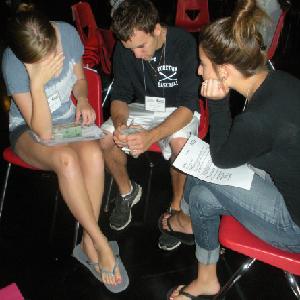Bulletin News

03/19/2013
For several years, a partnership among SUNY Cortland and Cortland community organizations has given students and staff a much deeper understanding of what it means to live in poverty.
And for the second time this semester, the College’s Institute for Civic Engagement (ICE) and the Cortland County Community Action Program (CAPCO) will present “The State of Poverty Simulation” from 9 to 11 a.m. on Saturday, March 23. This two-hour simulation allows participants to better understand the frustrations of those at an economic disadvantage.
According to John Suarez, who coordinates the College’s Service-learning Office through the ICE, the simulation usually is held once a semester. Demand for the program is growing and there is a waiting list for participants. Suarez and anticipate that there will be two simulations per semester, during the 2013-14 academic year.
The hands-on event begins by providing participants with the government-defined terms of poverty, minimum wage and living wage.
Next, in four 15-minute intervals that imitate a four-week period, attendees adopt the roles of those living in poverty. The roles are based on real-life situations and real-life people who are struggling to make ends meet.
Some roles include individuals who are newly unemployed, recently deserted by the family’s main source of income, recipients of Aid to Families with Dependent Children, disabled, or senior citizens receiving social security.
Following the first half of the event, participants contribute their reactions, reflect on what they experienced and get a chance to learn from each other in a group discussion.
Several years ago, Suarez was approached by CAPCO executive director Lindy Glennon to help her plan the poverty simulation. Suarez is constantly striving to give students the opportunity to be active participants in their learning and in teaching each other. He found just what he had been looking for in the Poverty Simulation.
“Students who have attended the simulation acquired a much deeper understanding about the complexity of poverty,” Suarez said. “Many had a strong desire to help those in need and also a much stronger empathy with people living in poverty.
“Some students even reversed their original opinions about poverty.”
Approximately 80 people — mostly students from a variety of academic disciplines — attended this semester’s first Poverty Simulation on March 6. In past years, the event was staged for College students and staff as well as local public school educators and administrators.
The upcoming Poverty Simulation was organized by Kerri Freese, who coordinates the College’s Noyce Project, which encourages talented science, technology, engineering and mathematics (STEM) majors and professionals to become K-12 mathematics and science educators.
”Part of our goal is to help our teachers be successful in high-need environments,” said Freese. “By understanding how it is to live in poverty, hopefully our scholars will be better prepared to address the needs of these students and to help them achieve despite the barriers they may face.”
The simulation is geared toward educators, according to Freese and Suarez, as this event could potentially help them identify a student living in poverty, which may explain their behavior in the classroom.
The event is free but space is limited. To reserve a place as a participant, call Suarez in advance at 607-753-4391 or email Kerri Freese.

